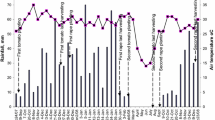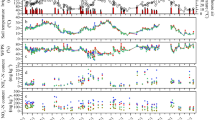Abstract
Nitrate pollution due to excessive N fertirrigation in greenhouse tomato production is a persisting environmental concern in the Mediterranean region. Driven by productivity rather than sustainability, growers continue to use very high N concentrations of more than 11 mM in greenhouse tomato production. A greenhouse study was conducted in Barcelona, Spain, over two growing seasons to analyze the effect of N concentrations from 5 mM to 11 mM (control) on tomato yield and physical quality. The relative environmental impact was calculated by using the life cycle assessment method (LCA). Our results show that N concentration in the nutrient solution can be reduced from 11 mM (control) to 7 mM under a daily mean drainage volume of 30%. This finding implies a 70% decrease in nitrate leaching without reducing tomato yield or quality. According to life cycle assessment, a reduction of 36% in N fertilizers leads to a 60% decrease in the potential impact of eutrophication, 50% decrease in the potential impact of climate change, and 45% decrease in the potential impact of photochemical oxidants.
Similar content being viewed by others
References
Antón A. (2004) Utilizatión del Análisis del Ciclo de Vida en la Evaluation del Impacto ambiental del cultivo bajo invernadero Mediterráneo, Tesis doctoral Thesis, Universitat Politècnica de Catalunya, Barcelona.
Anton A., Montero J.I., Muñoz P., Castells F. (2005) Identification of the main factors affecting the environmental impact of passive greenhouses, Acta Hort. 691, 489–494.
Andersen J.H., Schluter L., Gunni A. (2006) Coastal eutrophication: recent developments in definitions and implications for monitoring strategies, J. Plankton Res. 28, 621–628.
Audsley E. (1997) Harmonisation of environmental life cycle assessment, in: Final Report Concerted Action AIR3-CT94-2028, European Commission DG VI Agriculture.
Council Directive of 12 December 1991 concerning the protection of waters against pollution caused by nitrates from agricultural sources (91/676/EEC).
Cowell S.J. (1998) Environmental Life Cycle Assessment of Agricultural Systems: Integration Into Decision-Making, Ph.D. Thesis, University of Surrey, Guildford.
Cowell S.J., Clift R. (1997) Impact assessment for LCAs [Life Cycle Assessments] involving agricultural production, Int. J. Life Cycle Assessment 2, 99–103.
De Pascale S., Maggio A. (2005) Sustainable protected cultivation at a Mediterranean climate: perspectives and challenges, Acta Hort. 691, 29–42.
DEAM® (1999) Data for Environmental Analysis and Management, Écobilan, France.
Duchein M.C., Baille M., Baile A. (1995) Water use efficiency and nutrient consumption of a greenhouse rose crop grown in rockwool, Acta Hort. 408, 129–135.
Ehret D.L., Alsanius B., Wohanka W., Menzies J.G., Utkhede R. (2001) Disinfection of recirculating nutrient solutions in greenhouse horticulture, Agronomie 21, 323–339.
Guinée J.B., Gorrée M., Heijungs R., Huppes G.R.K., de Koning A., Wegener Sleeswijk A., Suh S., Udo de Haes H., Bruijn H., Duin R.V., Huijbregts M.A.J. (2002) Handbook on life cycle assessment, Operational guide to the ISO standards. Dordrecht, Kluwer, The Netherlands.
Incrocci L., Pardossi A., Malorgio F., Maggini R., Campiotti C.A. (2003) Cascade cropping system for greenhouse soilless culture, Acta Hort. 609, 297–300.
ISO-14040 (1997) Environmental management — Life cycle assessment — Principles and framework, International Organisation for Standardisation ISO, International standard, 14040, Geneva.
ISO-14044 (2006) Environmental management — Life cycle assessment — Requirements and guidelines. 14044, International Organisation for Standardisation ISO, Geneva.
Jolliet O. (1993) Bilan écologique de la production de tomates en serre, Rev. S. Vitic. Arboric. Hortic. 25, 261–267.
Kläring H.P. (2001) Strategies to control water and nutrient supplies to greenhouse crops. A review, Agronomie 21, 311–321.
Le Bot J., Jeannequin B., Fabre R. (2001) Impacts of N-deprivation on the yield and nitrogen budget of rockwool grown tomatoes, Agronomie 21, 341–350.
Larouche R., Vezina L., Gosselin A. (1989) Nitrogen concentration and photosynthetic photon flux in greenhouse tomato production. I. Growth and development, J. Am. Soc. Hort. Sci. 114, 458–461.
Mattsson B. (1999) Life cycle assessment (LCA) of carrot puree: case studies of organic and integrated production.
Méar C., De Brest R. (1998) Les serristes visent le zéro pollution, Culture Légumière 47, 9.
Milà L. (2003) Contributions to Life Cycle Analysis for Agricultural Systems. Site-dependency and soil degradation impact assessment, Thesis doctoral, Universitat Autònoma, Bellaterra.
Muñoz P., Ariño J., Montero J.I., Antón A. (2005) Cascade crops: a method proposed for increasing sustainability in el Maresme, in: Agriculture and Energy: Case studies in the agro-industrial sector, Vol. I, pp. 468–472.
Muñoz P., Antón A., Montero J.I. (2006) Fertilization nitrogenada en un cultivo hidropónico de tomate, Hort. Int. 24, 8–13.
Nienhuis J.K., Vreede P.J.A.D., De Vreede P.J.A., Brumfield R.G. (1996) Utility of the environmental life cycle assessment method in horticulture, Proceedings of the XIIIth International Symposium on Horticultural Economics, Rutgers, New Brunswick, New Jersey, USA, pp. 531–538.
Pardossi A. (2005) The management of plant mineral nutrition in soilless culture, in: Fernández M., Minguéz P.L., Gómez I.M. (Eds.), Improvement of water use efficiency in protected crops, p. 122.
Royal Decree 261/1996, Ministerio de la Presidencia. 1996. BOE num. 11.
Royal Decree 140/2003, Ministerio de la Presidencia. 2003. BOE num. 45.
Runia W.T., Van Os E.A., Bollen G.J. (1998) Disinfection of drainwater from soilless cultures by heat treatment, Neth. J. Agr. Sci. 36, 231–238.
Russo G., Scarascia-Mugnozza G. (2004) LCA methodology applied to various typology of greenhouses, in: Bot G., Marcelis L. (Eds.), Sustainable greenhouse systems, Wageningen University and Research Centre, Leuven, Belgium.
Siddiqi M.Y., Kronzucker H.J., Britto D.T., Glass A.D.M. (1998) Growth of a tomato crop at reduced nutrient concentrations as a strategy to limit eutrophication, J. Plant Nutr. 21, 1879–1998.
Steiner A.A. (1966) The influence of chemical composition of a nutrient solution of the production of tomato plants, Plant Soil 24, 454–466.
TEAM® (1999) Tools for environmental analysis and management, Écobilan, France.
Thompson R.B., Martínez-Gaitan C., Gallardo M., Giménez C., Fernández M.D. (2007), Identification of irrigation and N management practices that contribute to nitrate leaching loss from an intensive vegetable production system by use of a comprehensive survey, Agr. Water Manage. 89, 261–274.
Van Noordwijk M. (1990) Synchronisation of supply and demand is necessary to increase efficiency of nutrient use in soilless horticulture, in: Van Beusichem M.L. (Ed.), Plant nutrition — physiology and applications, pp. 525–531.
Van Woerden S. (2001) The application of Life Cycle Analysis in glasshouse horticulture, International Conference LCA in Foods, Gothenburg, pp. 136–140.
Wegener Sleeswijk A. et al. (1996) Application of LCA to Agricultural Products, CML report 130, Centre of Environmental Science Leiden University (CML), Centre of Agriculture and Environment (CLM), Agricultural-Economic Institute (LEI-DLO), Leiden.
Wilcox G.E., Magalhes J.R., Silva F.L.I.M. (1985) Ammonium and nitrate concentrations as factors in tomato growth and nutrient uptake, J. Plant Nutr. 8, 989–998.
Author information
Authors and Affiliations
Corresponding author
About this article
Cite this article
Muñoz, P., Antón, A., Paranjpe, A. et al. High decrease in nitrate leaching by lower N input without reducing greenhouse tomato yield. Agron. Sustain. Dev. 28, 489–495 (2008). https://doi.org/10.1051/agro:2008024
Accepted:
Issue Date:
DOI: https://doi.org/10.1051/agro:2008024




